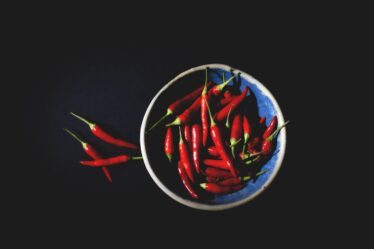
Thai red pepper flakes, also known as prik bon in Thai, are a popular ingredient in Thai cuisine. They add a fiery kick to dishes and are loved for their vibrant color and intense flavor. These flakes are made from dried Thai chili peppers, which are known for their spiciness. Thai red pepper flakes have a long history and are believed to have originated in Thailand, where chili peppers have been cultivated for centuries.
The flavor of Thai red pepper flakes is bold and spicy, with a hint of sweetness. They have a heat level that ranges from mild to very hot, depending on the variety of chili peppers used. The heat is measured on the Scoville scale, which is a measurement of the concentration of capsaicin, the compound responsible for the spiciness of chili peppers. Thai red pepper flakes typically have a heat level of 30,000 to 50,000 Scoville heat units, making them hotter than jalapenos but not as hot as habaneros.
Key Takeaways
- Thai red pepper flakes offer a spicy kick to any dish and are a staple in Thai cuisine.
- They contain capsaicin, which has been linked to various health benefits such as pain relief and improved digestion.
- Thai red pepper flakes can be used in a variety of dishes, from soups and curries to marinades and rubs.
- When cooking with Thai red pepper flakes, start with a small amount and adjust to taste, as they can be very spicy.
- To store Thai red pepper flakes, keep them in an airtight container in a cool, dry place away from sunlight.
Health Benefits of Thai Red Pepper Flakes
In addition to adding flavor and heat to dishes, Thai red pepper flakes also offer several health benefits. They are rich in vitamins and minerals, including vitamin C, vitamin A, potassium, and iron. These nutrients are essential for maintaining a healthy immune system, promoting good vision, and supporting overall well-being.
Thai red pepper flakes can also boost metabolism and aid in weight loss. The capsaicin in chili peppers has been shown to increase thermogenesis, which is the process by which the body burns calories to produce heat. This can help speed up metabolism and promote weight loss.
Furthermore, Thai red pepper flakes have anti-inflammatory and pain-relieving properties. Capsaicin has been found to reduce inflammation and alleviate pain by inhibiting the production of substance P, a neurotransmitter that plays a role in transmitting pain signals. This makes Thai red pepper flakes a natural remedy for conditions such as arthritis and muscle soreness.
Culinary Uses of Thai Red Pepper Flakes
Thai red pepper flakes are a staple in Thai cuisine and are used in a variety of dishes. They add heat and flavor to soups, stir-fries, curries, and marinades. Some popular Thai dishes that incorporate Thai red pepper flakes include Tom Yum soup, Pad Thai, and Green Curry.
In addition to traditional Thai dishes, Thai red pepper flakes can also be incorporated into other cuisines to add a spicy kick. They can be sprinkled on top of pizzas, added to pasta sauces, or used to season grilled meats and vegetables. The versatility of Thai red pepper flakes allows them to be used in a wide range of dishes, from Asian-inspired stir-fries to Mexican salsas.
Tips for Cooking with Thai Red Pepper Flakes
| Tips for Cooking with Thai Red Pepper Flakes |
|---|
| 1. Use sparingly as they are very spicy |
| 2. Toast them in a dry pan before using to enhance their flavor |
| 3. Add them to soups, stews, and curries for a spicy kick |
| 4. Mix with other spices like garlic and ginger for a flavorful marinade |
| 5. Store in an airtight container in a cool, dry place to maintain freshness |
When cooking with Thai red pepper flakes, it’s important to keep in mind that they are quite spicy. If you prefer milder heat, you can adjust the amount of flakes used in a recipe or remove the seeds from the chili peppers before drying and grinding them into flakes.
Thai red pepper flakes pair well with a variety of foods. They can be sprinkled on top of pizza or pasta for an extra kick, added to marinades for grilled meats, or used to season roasted vegetables. They also work well in spicy sauces and dressings.
To release the full flavor of Thai red pepper flakes, it’s best to toast them briefly in a dry skillet before using them in a recipe. This will help enhance their aroma and bring out their natural oils.
How to Store Thai Red Pepper Flakes
To maintain the freshness and flavor of Thai red pepper flakes, it’s important to store them properly. The best way to store them is in an airtight container in a cool, dark place, such as a pantry or cupboard. This will help protect them from moisture and light, which can cause them to lose their flavor and potency.
Thai red pepper flakes have a shelf life of about one to two years if stored properly. However, over time, their flavor and heat level may diminish. To ensure that you are using fresh flakes, it’s a good idea to check the expiration date on the packaging.
Thai Red Pepper Flakes vs. Other Types of Pepper Flakes

Thai red pepper flakes have a distinct flavor profile and heat level that sets them apart from other types of pepper flakes. Compared to milder varieties such as paprika or cayenne pepper, Thai red pepper flakes are much spicier and have a more intense flavor.
In terms of heat level, Thai red pepper flakes are hotter than jalapeno flakes but not as hot as habanero flakes. They fall somewhere in the middle of the Scoville scale, making them a good choice for those who enjoy a moderate level of spiciness.
When it comes to flavor, Thai red pepper flakes have a unique combination of sweetness and spiciness. They add depth and complexity to dishes, making them a popular choice in Thai cuisine.
Where to Buy Thai Red Pepper Flakes
Thai red pepper flakes can be found in specialty Asian grocery stores or online. There are several brands that offer high-quality Thai red pepper flakes, such as Mae Ploy and Pantai Norasingh. It’s important to choose a reputable brand to ensure that you are getting authentic Thai red pepper flakes.
When buying Thai red pepper flakes online, it’s a good idea to read reviews and check the seller’s reputation. Look for sellers that offer fresh and high-quality products.
Thai Red Pepper Flakes in Traditional Thai Cuisine
Thai red pepper flakes play a prominent role in traditional Thai cuisine. They are used in a variety of dishes to add heat and flavor. Some examples of traditional Thai dishes that use Thai red pepper flakes include:
1. Tom Yum Soup: This popular Thai soup is known for its spicy and sour flavors. Thai red pepper flakes are added to the broth to give it a fiery kick.
2. Pad Thai: This classic Thai noodle dish is made with stir-fried rice noodles, shrimp or chicken, eggs, and a tangy sauce. Thai red pepper flakes are often sprinkled on top for added heat.
3. Green Curry: This aromatic curry is made with a paste of green chili peppers, garlic, lemongrass, and other spices. Thai red pepper flakes are added to the curry paste to give it a spicy kick.
Regional variations and specialties
In different regions of Thailand, there are variations of dishes that use Thai red pepper flakes. For example, in the northeastern region of Thailand, known as Isaan, a popular dish called som tam is made with shredded green papaya, tomatoes, peanuts, and Thai red pepper flakes. This dish is known for its spicy and tangy flavors.
In southern Thailand, Thai red pepper flakes are used in dishes such as gaeng som, a sour and spicy soup made with fish or shrimp, tamarind paste, and various vegetables. The addition of Thai red pepper flakes gives this soup its signature heat.
Thai Red Pepper Flakes in Fusion Cuisine
Thai red pepper flakes are not only used in traditional Thai dishes but also in fusion cuisine. Chefs around the world have incorporated Thai red pepper flakes into non-Thai dishes to add a spicy twist. Some examples of fusion dishes that use Thai red pepper flakes include:
1. Spicy Mango Salsa: This refreshing salsa combines diced mangoes, red onions, cilantro, lime juice, and Thai red pepper flakes for a sweet and spicy flavor.
2. Thai-inspired Tacos: These tacos are filled with grilled chicken or shrimp marinated in a mixture of Thai red pepper flakes, lime juice, fish sauce, and garlic. They are topped with a spicy peanut sauce and fresh herbs.
3. Spicy Peanut Noodles: This dish combines cooked noodles with a spicy peanut sauce made with Thai red pepper flakes, peanut butter, soy sauce, and lime juice. It’s a flavorful and satisfying meal.
Recipes Featuring Thai Red Pepper Flakes
1. Thai Red Curry Chicken
Ingredients:
– 1 lb boneless, skinless chicken breasts, cut into bite-sized pieces
– 2 tbsp Thai red curry paste
– 1 can (14 oz) coconut milk
– 1 cup chicken broth
– 1 tbsp fish sauce
– 1 tbsp brown sugar
– 1 cup sliced bell peppers
– 1 cup sliced bamboo shoots
– Thai red pepper flakes, to taste
– Fresh basil leaves, for garnish
Instructions:
1. Heat a large skillet over medium heat and add the Thai red curry paste. Cook for 1 minute until fragrant.
2. Add the chicken to the skillet and cook until browned on all sides.
3. Stir in the coconut milk, chicken broth, fish sauce, and brown sugar. Bring to a simmer and cook for 10 minutes.
4. Add the bell peppers and bamboo shoots to the skillet and cook for an additional 5 minutes.
5. Season with Thai red pepper flakes to taste.
6. Serve the curry over steamed rice and garnish with fresh basil leaves.
2. Spicy Thai Peanut Noodles
Ingredients:
– 8 oz rice noodles
– 2 tbsp vegetable oil
– 2 cloves garlic, minced
– 2 tbsp soy sauce
– 2 tbsp peanut butter
– 1 tbsp honey
– 1 tbsp lime juice
– 1 tsp Thai red pepper flakes
– 1 cup shredded carrots
– 1 cup sliced bell peppers
– 1 cup chopped green onions
– Chopped peanuts, for garnish
– Fresh cilantro, for garnish
Instructions:
1. Cook the rice noodles according to the package instructions. Drain and set aside.
2. Heat the vegetable oil in a large skillet over medium heat. Add the garlic and cook for 1 minute until fragrant.
3. In a small bowl, whisk together the soy sauce, peanut butter, honey, lime juice, and Thai red pepper flakes.
4. Add the sauce to the skillet and stir to combine with the garlic.
5. Add the cooked rice noodles, shredded carrots, bell peppers, and green onions to the skillet. Toss to coat everything in the sauce.
6. Cook for an additional 2-3 minutes until heated through.
7. Serve the noodles garnished with chopped peanuts and fresh cilantro.
3. Thai Red Pepper Flakes Roasted Cauliflower
Ingredients:
– 1 head cauliflower, cut into florets
– 2 tbsp olive oil
– 1 tsp Thai red pepper flakes
– Salt and pepper, to taste
Instructions:
1. Preheat the oven to 425°F (220°C).
2. In a large bowl, toss the cauliflower florets with olive oil, Thai red pepper flakes, salt, and pepper.
3. Spread the cauliflower in a single layer on a baking sheet.
4. Roast in the preheated oven for 25-30 minutes until golden brown and crispy.
5. Serve as a side dish or as a topping for salads or grain bowls.
These recipes showcase the versatility of Thai red pepper flakes and how they can be used to add flavor and heat to a variety of dishes. Whether you’re making a traditional Thai curry or experimenting with fusion cuisine, Thai red pepper flakes are a great ingredient to have in your pantry.
If you’re a fan of Thai cuisine and love adding a spicy kick to your dishes, then you’ll definitely want to check out this article on Flavorful Sips. They have a fantastic recipe for Simple Shrimp Tikka Masala that incorporates the bold flavors of Thai red pepper flakes. This dish is sure to satisfy your cravings for both heat and deliciousness. So, if you’re looking to spice up your dinner routine, give this recipe a try by clicking here.



